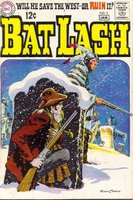
As I have noted in the past, one of DC's major trends of the late 1950s and early 1960s was to add continuing characters to the magazines that did not already feature them. The war books picked up Sgt Rock, Jeb Stuart, Gunner and Sarge, etc., while Mystery in Space added Adam Strange, Tales of the Unexpected featured Space Ranger, and House of Secrets highlighted Mark Merlin.
Strange Adventures, edited by Julius Schwartz, tried something different. Instead of adding one feature which appeared every issue, Schwartz rotated several recurring features: Star Hawkins, the Atomic Knights and the Space Museum appeared regularly over the course of several years. In addition, particularly successful one-shot characters were often brought back. The Faceless Creature was probably the most notable as he appeared on the covers of three* issues over the course of as many years. Those of you who are fans of the Brave and the Bold show on Cartoon Network may recognize him as the Hunter who served as Starro's herald in a two-part episode of that series.
As the first story (Strange Adventures #124, January 1961) begins, two Highway Patrolmen in South Dakota, Jim Boone and Bob Colby, are investigating the disappearance of the heads from Mount Rushmore. The heads disappear along with some other famous giant faces around the world, but then are returned. An alien spacecraft lands and:

After preventing them from firing their weapons as shown on the cover, the alien introduces himself as Klee-Pan from the planet Klaramar, which is a sub-atomic world revolving within a single atom of the Planet Jupiter. He explains that he is looking for a giant head which will unlock a vault where a bomb was hidden by a villain named Chen Yull (sometimes referred to as Chan Yull and also as Chun Yull). If the head is not located, the bomb will destroy the entire solar system in one second.
Well, one second on Klaramar, which is quite a bit longer on Earth:

The mathematician in me couldn't resist calculating that out. If one Klaramar day equals 1,000,000 Earth years, then one Klaramar second equals about 11-1/2 Earth years.
Klee-Pan has tried all the famous giant faces on Earth, but none of them work. Fortunately, Jim realizes the secret:

So he suggests the Woman in the Moon. Of course, most of us have heard of it as the Man in the Moon, but apparently the Chinese and South Dakotans have the gender reversed.
While the trio head to the Moon, Klee-Pan explains how his people became faceless:

That sequence would appear in each subsequent Faceless Creature story. They take the Woman in the Moon to Saturn, but Chen Yull has planned for this and destroys the face with ray guns. But Jim has another bright idea:

And by repairing the face, they are able to open the lock, defuse the bomb, and save the solar system. Klee-Pan offers them a reward, but all they want is for the face on the Moon to be restored.

The Faceless Creature returned in Strange Adventures #142 (July 1962). Chan Yull has learned that his prior plot to destroy the Solar System failed, partially because of the efforts of the two South Dakota Highway Patrolmen. So he creates a new bomb and uses them as the triggers:

But when they arrive the bomb does not explode. It turns out that Jim and Bob were given the power of telepathy by Klee-Pan, and so they had ordered each other not to explode the bomb. Klee-Pan sends them back to Earth with weapons that subdue Chen Yull and send him back to Klaramar.

Jim and Bob find themselves compelled to construct an odd, scientific device. When they turn it on:

Chen Yull heads to the UN Building, where he has a strange demand:

But when they do as he asks:

That seems a very strange quirk indeed. How useful an adaptation is it for a people to only be willing to destroy their own planet? Chen Yull reveals his fiendish plan:

Jim and Bob use the weapons they defeated Chen Yull with in the previous story on each other, shrinking themselves down while sending themselves to Klaramar. Once they are able to communicate with Klee Pan, he defeats Chen Yull and restores the two planets (and the Highway Patrolmen) to their normal sizes.
One other oddity about the series; according to the GCD, the pencils on the three stories were done by three different artists: Mike Sekowsky, Carmine Infantino and Gil Kane. I was able to identify the latter two, but the first one really doesn't look much like Sekowsky at all to me except for a few panels. Then again, I noticed how heavy the inks were on that story (by Murphy Anderson), so maybe it's just a case of the pencils being overwhelmed.
*Technically two different faceless creatures appeared on the three covers; Klee-Pan on the first issue and Chan Yull on the other two.




























